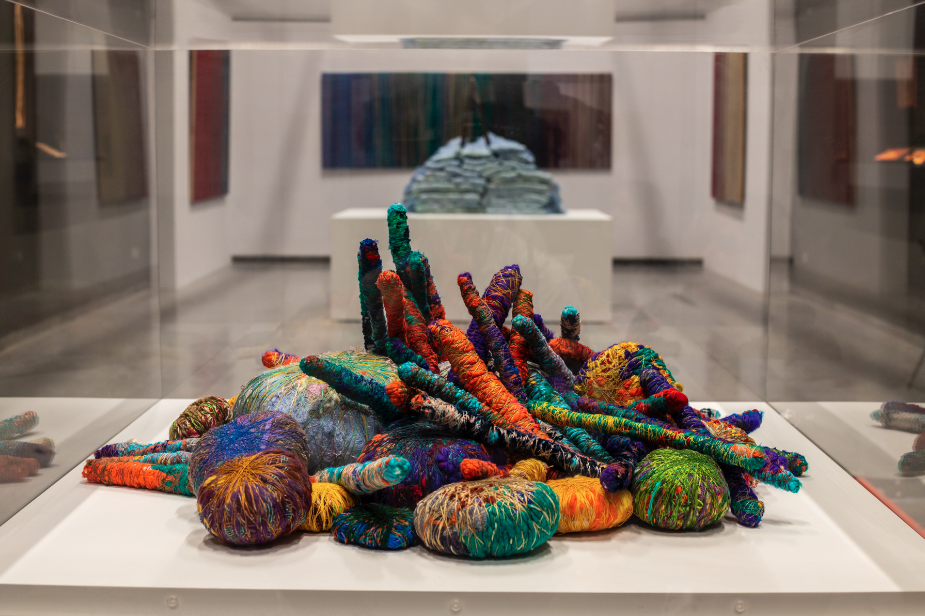Sheila Hicks vuelve a Chile después de cincuenta años con la exposición Reencuentro, presentada por el Museo Chileno de Arte Precolombino y Escondida | BHP. A través de más de cincuenta de sus obras y una selec-ción de piezas del Museo Precolombino, algunas de ellas nunca antes exhibidas al público, Reencuentro presenta un amplio panorama del trabajo de la artista, mediante un recorrido temático que pone en diálogo el arte contemporáneo y la herencia del arte indígena andino.
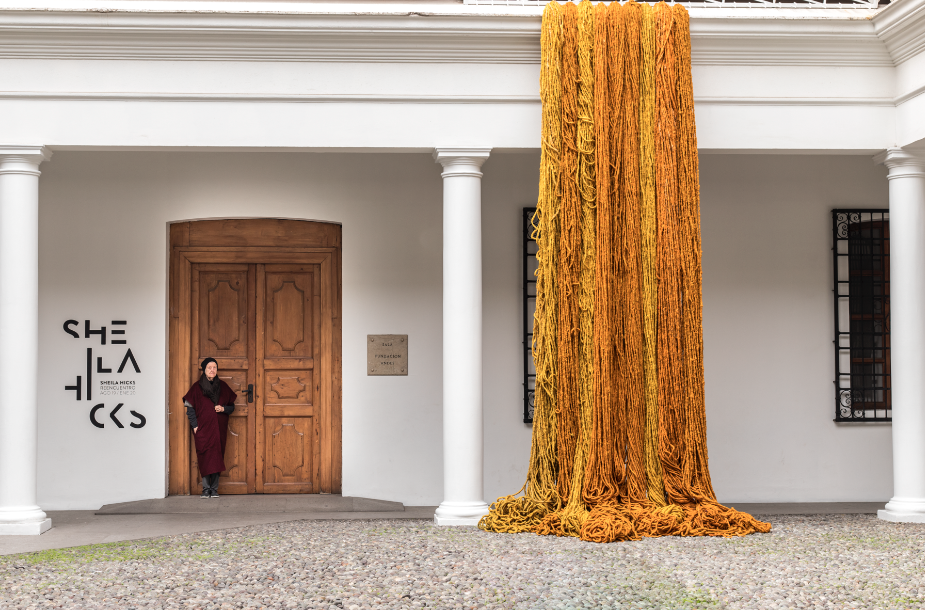
Reencuentro presenta el fascinante cuerpo de obra de Sheila Hicks, artista que ha encontrado en los hilados su medio, y en el color junto a la textura, su alfabeto estético. Las obras aquí exhibidas revelan la creación de formas inspiradas en modos ancestrales de comunicación a través de los hilados, volviendo a menudo a su encuentro inicial con los textiles precolombinos de los Andes.
La obra de Sheila Hicks es un arte de espacio y tiempo. Sus obras son un puente entre pintura, escultura y arquitectura, y entre arqueología, antropología y arte contemporáneo. La yuxtaposición de las obras de la artista con los textiles arqueológicos pertenecientes a la colección del Museo Chileno de Arte Precolombino permite mostrar el vínculo entre las influencias andinas y las diferentes expresiones estéticas de la artista.
Reencounter presents the fascinating work of Sheila Hicks. An artist who has found in fiber her medium, and along with color and texture, her aesthetic alphabet. The artworks exhibited here reveal forms inspired in ancestral modes of communicating through spun yarns. They often return to her first encounter with the pre-Columbian textiles of the Andes.
The works of Sheila Hicks are an art of space and time. Her artworks are bridges between painting, sculpture, and architecture; as well as between archeology, anthropology and contemporary art. Works on view and the archaeological textiles from the collection of the Chilean Museum of Pre-Columbian Art are juxtaposed to express the relation between the Andean influence and the artist’s different aesthetic expressions.
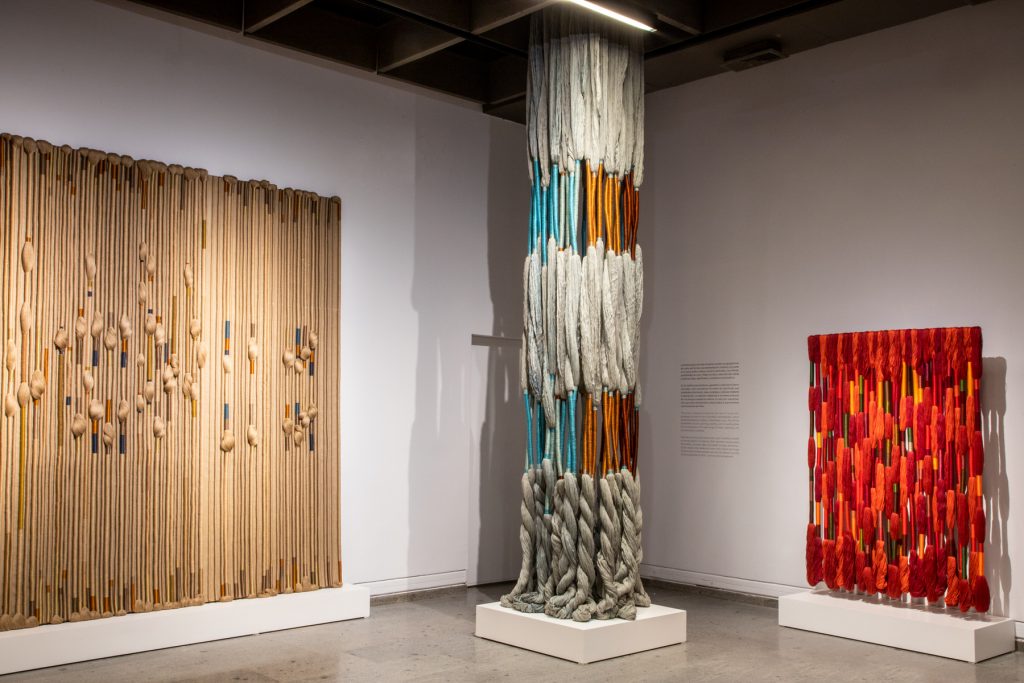
Hilo, unidad esencial
El hilo es la unidad esencial de sentido en el textil. El hilo es línea, fibra y color, y al igual que en el tejido precolombino, es la unidad fundamental para articular el lenguaje de Hicks. Un hilo se forma cuando dos cabos se tuercen juntos. A su vez, cada cabo es un ligado de fibras ordenadas por rotación. Las combinaciones de color en secuencias, madejas y cuerdas, complementan las variaciones de saturación, luz y matiz.
En la obra de Hicks lo visual es táctil y lo táctil es visual. A través de su manera asociativa de hacer arte, la artista toca la fibra y la transforma por medio de delicadas transferencias de significado. Es en esta cualidad donde radica el principal vínculo entre la obra de Hicks y los textiles precolombinos: las dos formas de arte son un soporte para la comunicación, el registro y la memoria.
Yarn, the Essential Unit
Yarn is the essence of a textile. A thread is line, fiber, and color. It is the fundamental unit for articulation both in pre-Columbian textiles and in Hicks aesthetic language. A yarn is formed when two threads are twisted together. In turn, each thread is a bound of fibers ordered by rotation. Color combinations in sequences, twists, and cords are complemented by variations in saturation, light, and hue.
In Hicks’ art the visual is haptic and the haptic is visual. Her associative art practice consists of touching fibers and transforming them through the delicate transferences of meaning. The main link between Hicks’ artwork and pre-Columbian textiles lies in the following quality: the two art forms are mediums of communication, record-keeping, and memory.
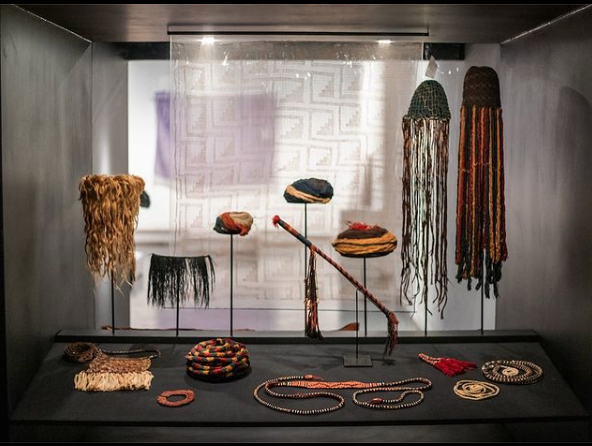
La artista explora de modo incesante cuerdas con agrupaciones de nudos que forman una representación simbólica, los cuales en el quipu andino indican números abstraídos. Las infinitas posibilidades de color, hilado, torcido y retorcido dan cabida a extensas ideas, significados y contextos comunicativos.
The artist incessantly explores the use of cords with groupings of knots to form a symbolic representation, which symbolize abstract numbers in the Andean quipu. The infinite possibilities of color, spinning, twisting, and re-twisting allow for the expression of a wide range of ideas, meanings, and communicative contexts.
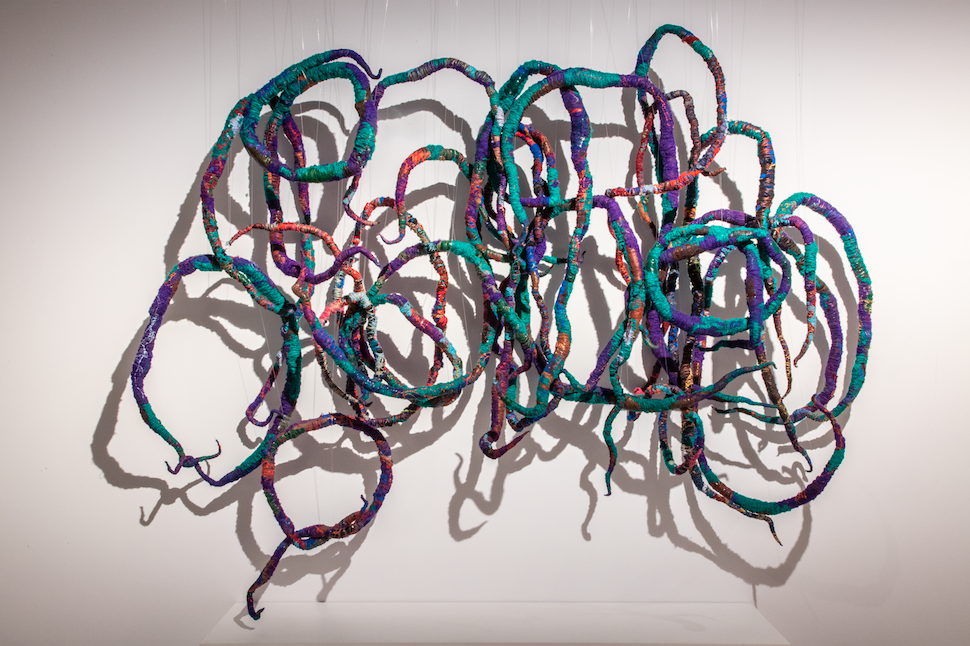
En los textiles precolombinos, geometría y estructura fueron utilizadas como portadores formales de significado que sintetizaban información, ideas complejas y creencias mediante la abstracción.La ambición intelectual y la inventiva técnica de los antiguos tejedores andinos no sólo son relevantes, sino que están directamente relacionados al acercamiento comunicacional de Hicks.
Geometry and structure were used in Pre-Columbian textiles as formal bearers of meaning. Both elements encapsulated information, complex ideas, and beliefs through abstraction. In this respect, the intellectual intent and creative technique of the ancient Andean weavers are not only relevant, but also directly applicable to Hicks’ communicational approach.
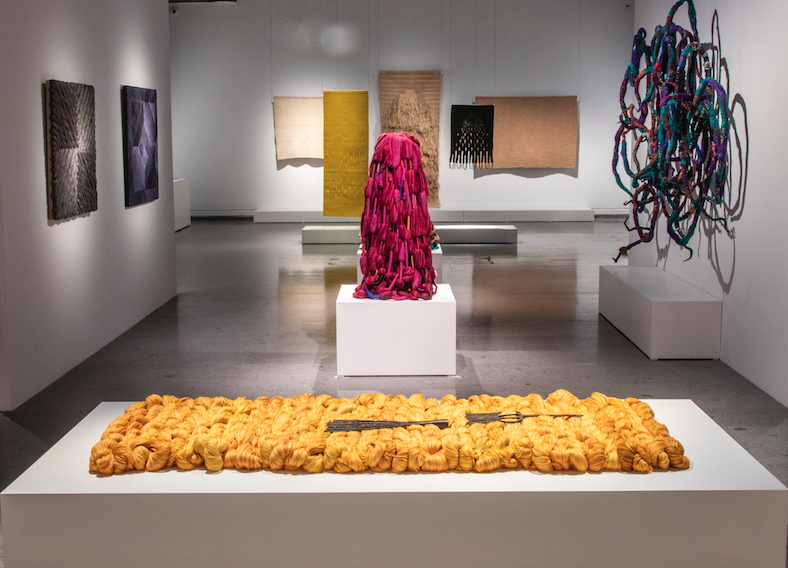
Analogías compositivas: arquitectura y fotografía
La obra de Sheila Hicks, el tejido andino y la arquitectura precolombina comparten analogías constructivas y compositivas. El ejercicio fotográfico de la artista es un entendimiento de las relaciones entre arte y espacio, lo sólido y lo vacío, siendo estudios y observaciones de la integridad del arte precolombino.
Hicks comenzó creando tejidos monocromáticos y altamente texturales para comprender las estructuras. El sistema del telar impone relaciones estructurales de lo horizontal y lo vertical, las cuales también se reflejan en las matrices de la arquitectura. Esta serie de obras están concebidas como un código extralingüístico, un soporte de comunicación, de registro y memoria, donde las variaciones e irregularidades de la estructura componen un mensaje específico.
Compositional Analogies: Architecture and Photography
The artwork of Sheila Hicks shares constructive and compositional analogies not only with Andean textiles, but also with pre-Columbian architecture. The artist’s photography practice is in itself an understanding of the relationship between art and space, solidity and emptiness, constituted in studies and observations on the integrity of pre-Columbian art.
Hicks began by creating monochromatic and highly textural weavings to understand structures. The loom system imposes structural relationships between the horizontal and the vertical, which are also reflected in the matrices of the architecture. This series was conceived as an extra-linguistic code–a medium for communication, record-keeping, and memory–in which the variations and irregularities of the structure compose a specific message.
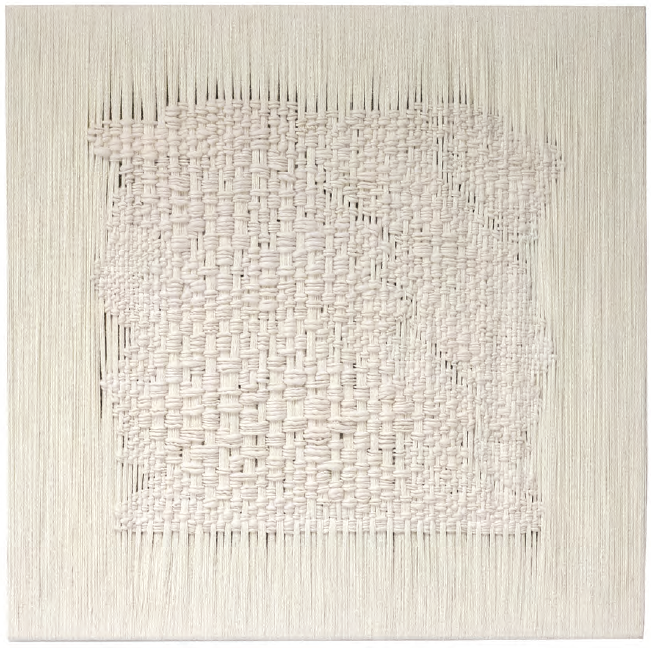
Recorrido textil: espacios cromáticos, paisaje y memoria
En 1957, Sheila Hicks viajó desde Venezuela hasta Tierra del Fuego, recorriendo Colombia, Ecuador, Argentina, Perú, Bolivia y Chile (1957-1959). En ese viaje por los Andes, aprendió de los tejedores locales cómo hilar la lana y tejer, para luego avanzar en su propia dirección. Fue en ese momento en que comienza a crear sus minimes, pequeños tejidos que nacieron como estudios de las técnicas precolombinas ancestrales, pero que evolucionaron como inquietudes estéticas.
Estas Minimes son obras atmosféricas, espacios cromáticos, estéticos y emocionales.Encarnan el entendimiento y la experimentación en materiales y estructuras, siempre en tejidos de cuatro orillas terminadas, técnica maestra de los antiguos tejedores andinos, donde la obra es contenida en sí misma por lo que nada puede ser quitado. Trazando paisajes, Hicks describe los Andes, no solo en sus títulos sino que también en colores y texturas, dotándolos de un sentido de lugar en vez de describir un paisaje figurativo.
Textile Journeys: Chromatic Spaces, Landscape, and Memory
In 1957, Sheila Hicks traveled from Venezuela to Tierra del Fuego. She traversed Colombia, Ecuador, Argentina, Peru, Bolivia, and Chile (1957-1959). On this journey through the Andes, she learned from the local weavers how to spin the wool and weave on a backstrap loom, and then continued in her own direction.It was there that she began to create her minimes, small weavings that were born as studies of ancestral pre-Columbian techniques, but that evolved into aesthetic enquiries.
These minimes are atmospheric artworks, aesthetics, chromatic, and emotional spaces. They embody Hicks’ understanding and experimentations with materials and structures, always in weavings of four finished selvedges, a technique mastered by the ancient Andean weavers, which renders the works structurally self-contained so nothing can be taken away. Tracing landscapes, the artist describes the Andes not only in the titles of her artworks but also through their colors and textures. Thus, imbuing them with a sense of the place instead of describing a figurative landscape.
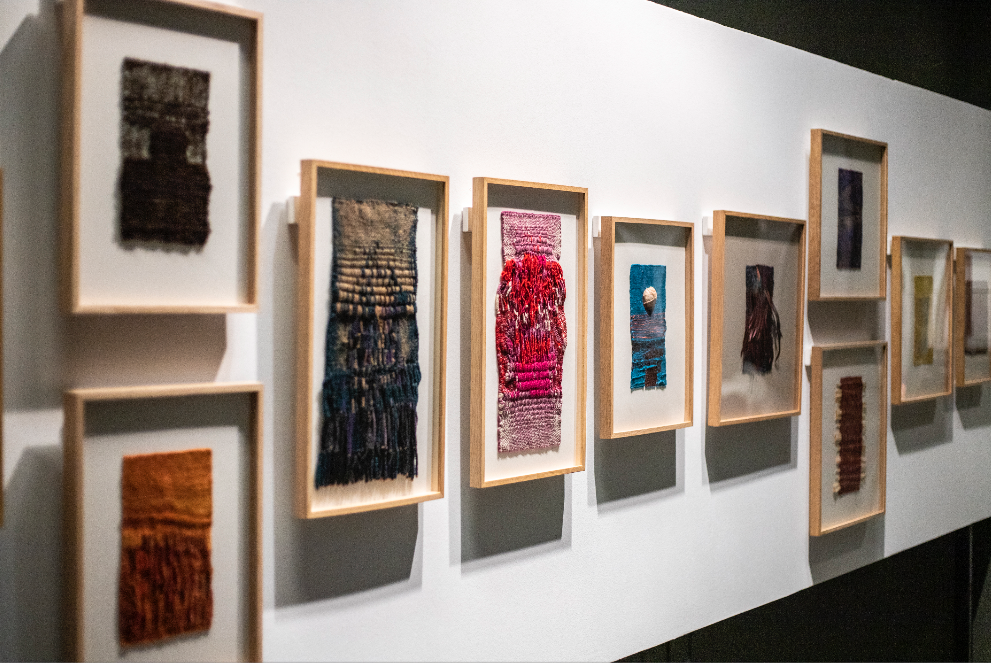
Ser textil
Hicks proyecta los hilos en tres dimensiones. La artista dota de una dimensión escultórica a sus obras, envolviendo con hilos y fibras, tesoros secretos de su vida. Al igual que en los pequeños “atados” precolombinos, objetos sagrados son contenidos en tejidos como ofrendas.
En la cosmovisión andina, el tiempo cíclico está presente en la integridad del universo, y se evidencia en el crecimiento de la semilla en la tierra de la cual emerge la vida. Las relaciones entre los seres son de reciprocidad, en una dimensión en el que cada ser pasa de un mundo a otro, transformándose en otro cuerpo.
Being Textile
Hicks projects the threads in three dimensions. Thus, the artist imbues her artworks with a sculptural dimension, enveloping secret treasures that pertain to her personal life with threads and fabrics. They resemble the small “bundles” created by pre-Columbian peoples, which are textiles containing sacred objects, like offerings.
Within the Andean cosmovision, cyclical time is presented in the integrity of the universe and evidenced in the growth of the seed that protrudes from the ground, the emergence of life. The relationships between beings are underscored by reciprocity, in a dimension in which each being passes from one world to another, transforming into another body.
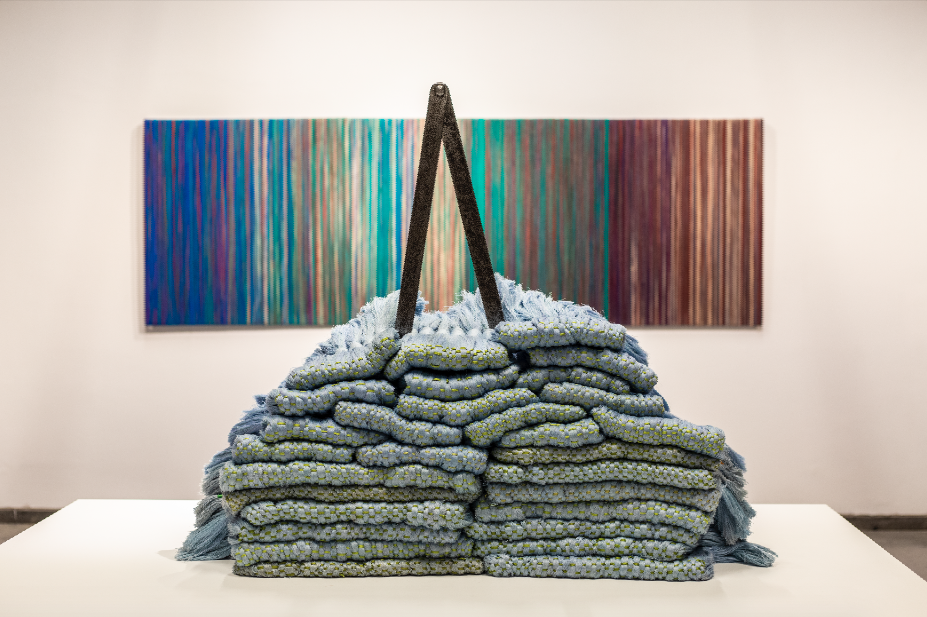
“El arte estimula la imaginación. Algunas de mis creaciones evocan eventos, personas, tiempos vividos, lugares visitados. Envolturas. Momias. Regalos. Puede ser una posesión o la prenda de una persona especial. La falda que vestí en una ocasión inolvidable. Lo que queda de los objetos preciosos que se han dispersado a mi favor. A medida que envuelvo una pieza pequeña, está toma vida por sí misma.”
“Art stimulates the imagination. The small works I call Hidden Treasures are often reminiscences of events, people, times lived, places visited. Wrapping, Mummies. Gifts. They may be an article of clothing of a special person. The skirt worn on an unforgettable occasion. What is left of precious objects fallen out of favor. As I wrap and envelope a small item it takes on a life of its own.”
